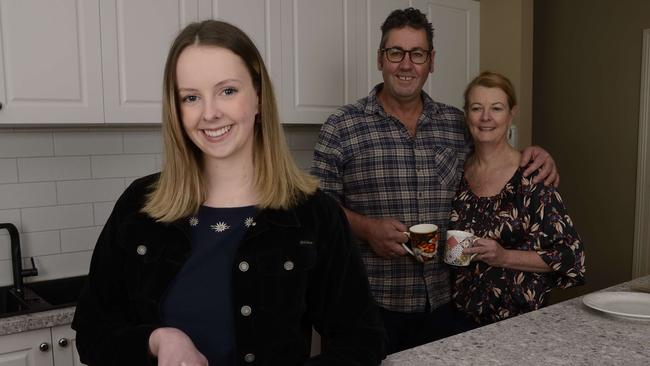Coronavirus: Empty nesters rescue flightless young
In March, 21-year-old Mairead Dullard was working three jobs in a gap year between her international relations degree and starting a Masters.

In March, 21-year-old Mairead Dullard was sharing a Melbourne apartment with friends and working three jobs in a gap year between her international relations and Middle Eastern politics degree and starting a Masters.
But all three jobs evaporated with COVID-19, including one where she missed out on JobKeeper by just five days. Gone is the trip to Europe at year’s end. Instead, she is back in the family home in Bendigo with her father Paul, a school principal, and mother Lisa, a theatre nurse.
Her parents were also readying for a different phase in their lives, with caravan trips, bike rides and long lunches in wineries on their to-do list. But they don’t mind their empty-nester status being interrupted. Both are busy at work in essential jobs but admit to being anxious about their daughter’s medium-term future.
“She will be fine in the short term, she’s here and safe,” Mrs Dullard said. “And I know in the long term things will be OK in terms of work, but it’s the next one or two years I really worry about, how the pandemic will affect her work and life.”
Her husband agrees. “There is such uncertainty about how long this is going to go on. Mairead had so many plans that have been put on hold,” he said. “I think everyone carries some anxiety, and it’s heightened during this period.”
COVID-19 is creating the great migration home, with new research from the Australian Institute of Family Studies revealing that one in five 50 to 59-year-olds reported their adult children had returned to the nest since the pandemic began.
The AIFS study, a survey of more than 7000 Australians conducted in May and June, also found that despite the proportion of people “always working from home” jumping from 7 per cent to 60 per cent as a result of the COVID-19 outbreak, the childcare and housework allocation within a family had barely changed, with women still around five times more likely to take on the primary role.
AIFS director Anne Hollonds says the proportion of 20-somethings living at home was already very high pre-COVID, at about 50 per cent of men and 43 per cent of women, and the pandemic only added to the crowded houses.
“There is a positive, though. Not that the young people are losing their jobs, which is terrible, but that they have families that are embracing their return and are willing and able to support them,” Ms Hollonds said.
“There is so much talk in these times about businesses pivoting, but when it comes to pivoting, to adapting, families are extraordinary — they turn themselves upside down and inside out at times like these.”
The study also shows that although far more men were now working from home, women were still five times more likely to take on the primary caring role with childcare and housework regardless of their work status.
“Even though we’re all spending so much more time at home, entrenched gender patterns are still evident — with women still taking on more household duties than men,” Ms Hollonds said.
“Early on in the pandemic, I was among those a little optimistic about a change in these gender roles. I said maybe it would take a pandemic to change, but housework and caring responsibilities seem to be pandemic-resistant.”
Ms Dullard admits she came back to Bendigo disgruntled about having to leave Melbourne.




To join the conversation, please log in. Don't have an account? Register
Join the conversation, you are commenting as Logout